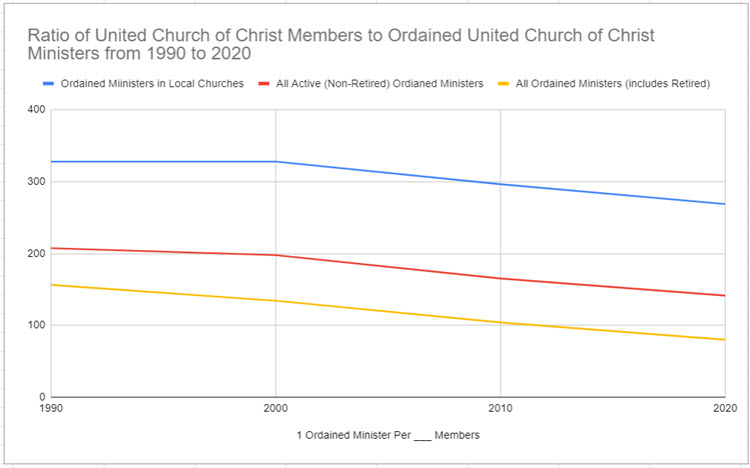Are there too many clergy in the United Church of Christ?
This question deserves real consideration in the context of decline in the United Church of Christ and in Mainline Protestantism more broadly. Thankfully, I’ve written about Mainline decline for the last fourteen years with a focus on the traditions I know best: United Church of Christ and Presbyterian Church (USA). A few examples of Mainline decline more generally are followed by analysis of the decline in the UCC and PC(USA).
Mainline Decline – General
- Mainline Decline in the Dallas – Fort Worth Metro Area (2023)
- Mainline Decline: 1990 to 2020 (2022)
- Mainline: The 5 Percent? (2019)
United Church of Christ Decline
- UCC Membership Decline: 2,193,593 to 773,539 (2022)
- UCC Decline Enters 7th Decade (2020)
- 6 Decades of Decline in the United Church of Christ (2018)
- Dwindling Membership: The United Church of Christ from 1965-2015 (2016)
- More Decline in the Mainline: UCC in Florida (2012)
Presbyterian Church (USA) Decline
- PC(USA) Membership – 30 Years of Decline (2023)
- End of Presbyterianism: Farewell PC(USA)? (2023)
- The Median Presbyterian (PCUSA) Congregation (2023)
- PC(USA) Membership Declines by 62% (2022)
- Presbyterian Decline: PCUSA -The First 35 Years (2020)
- The Presbyterian (PCUSA) Church is Deathly Ill (2011)
Decline in Ministers in the United Church of Christ
As membership in the United Church of Christ has declined, the number of ordained clergy has also declined. Over the last 30 years, however, the decline in clergy has been slower than the decline in membership.
To illustrate the change over time I looked up total membership in the United Church of Christ at 10 year intervals (1990, 2000, 2010, and 2020) then compared to the number of ordained ministers. For each year, I created a ratio showing the number of members per minister. In the chart below you’ll see the steady decline whether measuring the ratio just for ordained ministers in local churches, all active (non-retired) ordained ministers, or all ministers (including retired).

The following chart shows the declining ratio by clergy type.
| 1990 | 2000 | 2010 | 2020 | |
| Ordained Miinisters in Local Churches | 328 | 328 | 296 | 269 |
| All Active (Non-Retired) Ordained Ministers | 207 | 198 | 165 | 141 |
| All Ordained Ministers (includes Retired) | 156 | 134 | 104 | 80 |
The stats make sense when one places them in the context of ongoing decline. First, the number of churches has declined slower than total membership. Next, the percentage of retired clergy within total clergy has increased. As a result, it makes sense to focus on clergy who are serving local churches. This group held steady at 1 per 328 from 1990 to 2000 before falling to 296 in 201 and 269 in 2020.
Given these realities, I compared the ratio of ordained ministers in local churches over the same time per congregation.
| 1990 | 2000 | 2010 | 2020 | |
| Total Congregations | 6,330 | 5,923 | 5,227 | 4,794 |
| Ordained Miinisters in Local Churches | 4,879 | 4,202 | 3,572 | 2,878 |
| 1 Minister Per ____ Congregation | 1.30 | 1.41 | 1.46 | 1.67 |
Suddenly, what first appeared as an overage of clergy serving (as well as others potentially available to serve) local congregations is transformed into a shortage. Even a basic review of the chart above shows that there was less than 1 ordained minister per local congregation in 1990 (1 for every 1.3). The shortage has worsened each decade. (Also, keep in mind large congregations have multiple clergy.)
Additionally, this year’s report notes that “The vast majority (92.8%) of UCC members belong to congregations with 400 or fewer members with half (49.8%) attending congregations with 100 or fewer members. This reflects an overall trend within the UCC of membership being increasingly concentrated in smaller churches” (p.10).
So What?
Are there too many ordained ministers in the United Church of Christ? When focusing on those who engage in ministry in the setting of the local church, the clear answer is “no.”.
The reality is that there are too few and that those currently serving include an overrepresentation of those in the oldest age cohorts. More specifically, the report found, “Over one half of all active (non-retired) Authorized Ministers were age 60 and above (56.5%) and over three-quarters (78.6%) were 50 and older. Local church pastors and co-pastors are increasingly comprised of the oldest clergy in the UCC, with over half (56.2%) of all congregations in 2021 being served by authorized ministers aged 60 and above” (p.25).
Notes and Disclaimers:
- I recognize real decreases in the long-term viability among increasing numbers of congregations in the fastest growing membership category: small churches (apart from major changes that result in merger, acquisition, or radical changes that generate significant and ongoing growth in membership and financial support).
- I understand that the current shortage of ordained clergy serving or interested in serving in the local church setting is not a problem unique to the United Church of Christ.
- I’m aware that the traditional pathway to ordination is not the only way in which one may pastor a local congregation. Alternate pathways are not new and will likely continue to expand. Licensing is an additional consideration.
- As someone who has moved between Mainline denominations for many years, I’m also aware that UCC parishes are pastored by those ordained in full-communion traditions (and, in some cases, by clergy from traditions not in full-communion).
- I believe in the United Church of Christ and in its innovative and Spirit-led future. I plan to do my part to learn, grow, and serve.
- I am currently a candidate for ordination in the United Church of Christ (see Seeking Ordination – Update #8)..